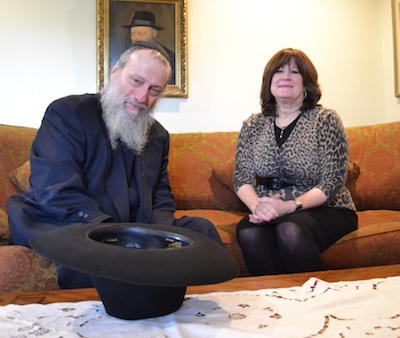By Emily K. Alhadeff , Associate Editor, JTNews
Assimilation, growing anti-Semitism, terrorism, a nuclear threat, war in Israel — news around the world paints a bleak picture of Jewish reality.
But Rabbi Sholom Ber and Chanie Levitin see the bright side.
“Tip the balance. One more mitzvah, you could be the one,” said Chanie Levitin at their North Seattle home last week. “By doing that mitzvah, you could be the one that will tip the balance and bring redemption of the world.”
Much has happened in the 40 years since the rabbi, his wife and their two young daughters moved to Seattle to pioneer Chabad-Lubavitch of the Pacific Northwest. They’ve built a shul, a mikvah, and educational programs, and they’ve seen Chabad centers sprout like mushrooms in the Northwest rain from Oregon to Alaska, all while raising what eventually became a family of 12 children. And they have no plans to slow down. With an affiliation rate of what the rabbi estimates at around 30 percent in the region, there’s still a lot of outreach to be done.
Rabbi Levitin recalls the decision to volunteer for emissary work that brought them to Seattle. Faced with the choice between Seattle and Baltimore, they left the decision up to their rabbi, Menachem Mendel Schneerson, better known as the Rebbe.
“The Rebbe underlined Seattle, and drew two arrows to Seattle,” Rabbi Levitin said. “Pretty strong.”
A leader in the Chabad movement informed Levitin of his responsibilities: “You’re the governor,” Levitin remembers him saying. “Anything Jewish which is necessary in all of these communities…you are responsible for. If someone needs kashrus in Montana, you’re the one responsible.”
For most Jews under 40, Chabad’s presence around the globe is a given. It is hard to imagine a time when Hassidic families did not open the doors to their homes on Friday nights to droves of strangers for challah, chicken and a few shots of slivovitz, or lead dancing in the streets on Simchat Torah, or perform stunts like driving around cities with huge electric menorahs on the roofs of their cars during Hanukkah.
But when the couple arrived in Seattle on October 15, 1972, things were different.
“They didn’t know what to make of the rabbi at first,” said Chanie Levitin. “People would ask, “˜How long are you going to stay?’ And I’d say, “˜We’re here.’ “˜No, but really, how long…Can I be your friend, or are you going to leave?’”
“That was a psychological change to many people,” said the rabbi. “Until the Messiah comes [and] takes us all back to Israel, that we’re really, really, really going to stay — that was radical.
“One of the things Chabad brought to Jewish life was, you know, “˜I can go to a place, because I know a Chabad is there.’”
The Levitins first settled in Seward Park. Six months later, the Chabad House in the University District was opened to serve students at the University of Washington, and another young couple moved in to run it. Within a couple of years, the Levitins moved to View Ridge to expand the community north.
The dynamism of the Chabad movement can be traced to Schneerson.
“The Rebbe himself started bringing a consciousness of Mashiach to the world,” said Chanie Levitin. “The Rebbe felt we’re not thinking enough about it. We’re not feeling enough about it. We’re not demanding it.
“He was the one, after the Holocaust, who took the ember and made a conflagration,” she said. “The Rebbe was all about doing something active, proactive. Do something.”
The idea that the Rebbe himself could be the Messiah had grown in the later years of his life, and his loss — in 1994, almost exactly halfway between the Levitins’ arrival and today — dealt a devastating blow to the Chabad community. But instead of crumbling, the movement grew stronger.
“By continuing to do the work, you are honoring the Rebbe’s vision and the Rebbe’s love for his fellow man, fellow Jew,” said Rabbi Levitin.
Rabbi Levitin frequently recounts stories of positive encounters with Jews and non-Jews alike, and it’s these experiences that give him his undying optimism. He keeps folders of letters from students at Seattle Prep, where he gives an annual presentation on Judaism. A random letter from a 15-year-old girl reads:
“You made me realize I want to do something more with my life…I never knew that the three pillars of Judaism are Torah, prayer and charity. I think, even though I am Catholic, I will try to incorporate these three pillars in my life and try to be present wherever I am, because of you.”
People are looking for spiritual guidance, Rabbi Levitin believes. They are waiting.
“That motivates and energizes me,” he said. “I can be dead tired at the end of the day…and I know someone could be waiting for my call. And I’m so tired. And I make that call, because that could be the call.”
